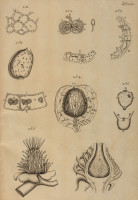Flower reproductive organs
Date
1674
Creator
Marcello Malpighi (1628 - 1694, Italian) , Physician
Object type
Archive reference number
Manuscript page number
p147r
Material
Dimensions
height (page): 319mm
width (page): 225mm
width (page): 225mm
Subject
Content object
Description
Sectional views of the changing forms of ovaries of various plant species’ flowers viewed under magnification, including:
Figure 281 [upper left]: Artichoke, Cinara, and Heliotrope, Heliotropium, referred to by Malpighi as Cinara and Heliotropio respectively.
Figure 282 [upper centre]: Wheat, Triticum, referred to as Tritico.
Figure 283 [upper right]: Almond tree, Prunus amygdalus, referred to as Amygdalis.
Figure 284 [centre]: Unidentified nut species referred to as Nux.
Figure 285 [centre right]: Hawthorn, Crataegus, referred to as Spinaceorum.
Figure 286 [lower row]: Chestnut tree, Castanea, referred to as Castaneis.
Each drawn on an individual slip of paper and arranged on the page for printing. Inscribed: ‘Tab XLIX’ in top right-hand corner.
Page 147 from MS/103/1, later published as Tab. XLIX in Marcello Malpighi's Anatome plantarum (1675).
Marcello Malpighi (1628-1694), Italian biologist and physician, was elected a Fellow of the Royal Society in 1669.
Figure 281 [upper left]: Artichoke, Cinara, and Heliotrope, Heliotropium, referred to by Malpighi as Cinara and Heliotropio respectively.
Figure 282 [upper centre]: Wheat, Triticum, referred to as Tritico.
Figure 283 [upper right]: Almond tree, Prunus amygdalus, referred to as Amygdalis.
Figure 284 [centre]: Unidentified nut species referred to as Nux.
Figure 285 [centre right]: Hawthorn, Crataegus, referred to as Spinaceorum.
Figure 286 [lower row]: Chestnut tree, Castanea, referred to as Castaneis.
Each drawn on an individual slip of paper and arranged on the page for printing. Inscribed: ‘Tab XLIX’ in top right-hand corner.
Page 147 from MS/103/1, later published as Tab. XLIX in Marcello Malpighi's Anatome plantarum (1675).
Marcello Malpighi (1628-1694), Italian biologist and physician, was elected a Fellow of the Royal Society in 1669.
Object history
Marcello Malpighi’s research on the anatomy of plants was encouraged and supported by the Royal Society, as evidenced by correspondence between him and the then-Secretary, Henry Oldenburg FRS (1619-1677) in the 1660s and 1670s [MS/103/1].
An abstracted version of his work in this area was first read at a Society meeting on 7 December 1671 [JBO/4, pp.216-217]. The full manuscript of Anatome Plantarum, together with the frontispiece artwork and these plates, was received and read on 28 January 1674/75 [MS/103/1-2].
It was ordered for printing by the Society’s printer John Martin in June 1675 [CMO/1/221]. The published work consists of the text of Anatome Plantarum and De ovo incubato as an appendix, and 61 plates illustrating each [54 and 7 respectively].
An abstracted version of his work in this area was first read at a Society meeting on 7 December 1671 [JBO/4, pp.216-217]. The full manuscript of Anatome Plantarum, together with the frontispiece artwork and these plates, was received and read on 28 January 1674/75 [MS/103/1-2].
It was ordered for printing by the Society’s printer John Martin in June 1675 [CMO/1/221]. The published work consists of the text of Anatome Plantarum and De ovo incubato as an appendix, and 61 plates illustrating each [54 and 7 respectively].
Related fellows
Marcello Malpighi (1628 - 1694, Italian) , Physician
Associated place
